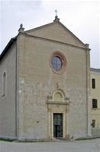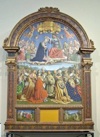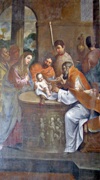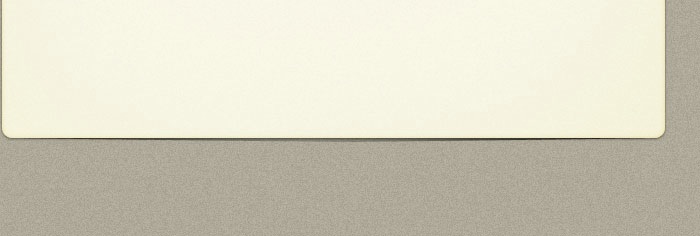

Maestro del Crocifisso di Trevi (early 14th century)
This artist is named for the painted Crucifix that still hangs in the apse of San Francesco. His work seems to have been inspired by Giotto. A fresco from Santa Croce that is also attributed to him is now in the Pinacoteca.
Maestro della Dormitio di Terni (ca. 1400)
All of the surviving frescoes in the presbytery of Santa Maria di Pietrarossa and on the arch in front of it are also attributed to the Maestro della Dormitio di Terni. These include a lovely standing Madonna and Child, part of which is illustrated here. A ruined fresco of the Annunciation on the facade of the ex-church of San Bartolomeo is also attributed to this master.
Maestro dell' Abside Destra di S Francesco (early 15th century)
A number of frescoes in San Francesco, Trevi are attributed to the Maestro dell' Abside Destra di S Francesco, including this one the exterior lunette of the portal.
Giovanni di Corraduccio Mazzaforte (died after 1437)
Two works in the Pinacoteca are attributed to Giovanni di Corraduccio Mazzaforte:
-
✴a triptych (early 15th century) from Santa Croce that depicts numerous scenes from the life of Christ; and
-
✴four panels from a polyptych (ca. 1430) from San Francesco. These depict scenes from the life of Christ, including this scene of the Flight into Egypt.
Bartolomeo da Miranda (died after 1449)
A number of frescoes signed by Bartolomeo da Miranda, which mostly depict the Madonna and Child, survive in Santa Maria di Pietrarossa, Trevi, including this one from the portico. A number of other frescoes in this and other rural churches around Trevi are attributed to him.
Maestro di Eggi (died after 1451)
Probably from Spoleto
Frescoes (15th century) in Santa Maria di Pietrarossa that are attributed to the Maestro di Eggi depict:
-
✴the Way to Calvary; and
-
✴Christ’s agony at Gethsemane.
[Temporary link to Maestro di Eggi]
Francesco da Pietrasanta (died 1494)
Plans by Francesco da Pietrasanta for the new church of Madonna delle Lacrime were approved in November 1485. He also supervised the early stages of its construction.
Valerio de’ Muti (died after 1502)
Valerio di Giacomo de’ Muti was documented in Foligno on a number of occasions in the period 1471-1502, but no securely attributed work by him survives in his native city. However, a fresco (1477) of the Annunciation on the left wall of Santa Maria di Pietrarossa is signed by him and dated by an inscription that also records the donor, “Marino de Parmaciu de Gironimo da Matigia”.
Pierantonio Mezzastris (ca. 1430-1506)
A painted and gilded cornice (ca. 1478), which probably came from a processional standard and which is now in the Pinacoteca, is attributed to Pierantonio Mezzastris. Circumstantial, evidence suggests that it had belonged to the Confraternita di Santa Maria della Piaggia and that it was the work documented in their church in the 18th century. It may well have been commissioned after the outbreak of plague in Trevi in 1478.
In 1488, the Consiglio dei Priori commissioned a series of frescoes from him for the Observant Franciscans’ newly built church of San Martino. This work has been largely lost, probably as a result of the re-modelling of the church in the late 16th century. This work has been largely lost, probably as a result of the re-modelling of the church in the late 16th century. However, this detached fresco in the presbytery may well have formed part of it.
Bernardino di Betto, Pintoricchio (ca. 1454–1513)
The provenance of this panel in the Pinacoteca is unknown before 1872, when it was documented in the civic collection. It has usually been attributed to Pintoricchio, and this attribution has been strengthened following its recent restoration. It may well have been a model for a similar but more finished image in the National Gallery, London, which is also attributed to Pintoricchio.
Francesco Melanzio (ca. 1465-1520)
Frescoes (ca, 1510) in Trevi that are attributed to Francesco Melanzio include:
-
✴fragments in Sant’ Emiliano, one of which is illustrated here; and
-
✴those in the chapel at the end of the right side of the portico of Santa Maria di Pietrarossa.
He signed an extensive fresco cycle (1510) in San Stefano, Picciche, outside Trevi, which is dated by inscription.
Tiberio d’ Assisi (ca. 1465 - 1524)
Works in Trevi by or attributed to Tiberio d’ Assisi include:
-
✴this signed fresco above the entrance to San Martino (illustrated here);
-
✴a detached fresco of St Martin sharing his cloak with a beggar, which is in the presbytery; and
-
✴an altarpiece of St Emilianus and a kneeling patron in the Cappella di San Girolamo there, which is also attributed to him.
Pietro Vannucci, il Perugino (1446–1524)
The aged Perugino executed the frescoes (1521) of the Cappella dei Magi of the Chiesa della Madonna delle Lacrime. The main scene of the Adoration of the Magi, which is signed, is set in a fictive Renaissance frame, with:
-
✴the figures of the Annunciation in tondi in the arch above; and
-
✴figures of SS Peter and Paul in painted niches to the sides.
Rocco di Tommas0 (died 1529)
Rocco di Tommaso built the Altare del SS Sacramento (1521-2) in Sant’ Emiliano (illustrated here). A carved a marble tabernacle (16th century) in Santa Maria di Pietrarossa is also attributed to him.
Giovanni di Pietro, lo Spagna (died 1528)
Works in Trevi by or attributed to lo Spagna include:
-
✴a fresco (1512) of the Assumption of the Virgin in San Martino (attributed);
-
✴documented frescoes (1518-20) in the Madonna delle Lacrime; and
-
✴two works that are now in the Pinacoteca:
-
•panels (ca. 1520) of SS Cecilia and Catherine from the Madonna delle Lacrime, (attributed); and
-
•the important, documented altarpiece (1522) of the Coronation of the Virgin from San Martino (illustrated here) from San Martino.
Simeone Ciburri (died 1624)
From Perugia
Filippo Palazzi commissioned the altarpiece (ca. 1613) on the Altare del Spirito Santo in San Francesco. This altarpiece, which depicts the Descent of the Holy Spirit, is attributed to Simeone Ciburri.
[Temporary link to Simeone Ciburri]
Giovanni Antonio Scaramuccia (died 1633)
From Perugia
Giovanni Antonio Scaramuccia was the most important artist in Perugia in the early 17th century. The decoration of the Cappella di Sant’ Agata in the Chiesa del Crocifisso, Trevi is attributed to him.
[Temporary link to Giovanni Antonio Scaramuccia]
Ascensidonio Spacca, il Fantino (1557-1646)
This This altarpiece (ca. 1620) in San Francesco is attributed to il Fantino. There are also a number of of his works in San Martino:
-
✴an altarpiece of the Immaculate Conception (1592) commissioned by Girolamo Fabri, which was originally in the 1st chapel on the right and is now on the high altar;
-
✴a fresco (1601) of the Last Supper, in the old refectory; and
-
✴frescoes (1601) of the stigmatisation of St Francis and 26 tondi containing Franciscan saints, in the cloister.
Bernardino Gagliardi (died 1660)
Bernardino Gagliardi signed this altarpiece (17th century) of the Circumcision of Jesus, which came from the Madonna delle Lacrime and is now in the Museo Diocesano, Spoleto. He also painted the frescoes (1645) of scenes from the life of St Francis in the cloister of San Francesco, but these have been largely repainted.
Domenico Bruschi (1840-1910)
From Perugia
Domenico Bruschi was one of the most important artists of the Risorgimento. He painted the fire curtain (1877) of the Teatro Clitunno with a scene of the Emperor Caligula arriving by boat at the Fonti del Clitunno.
[Temporary link to Domenico Bruschi]
Return to the home page on Trevi.

















